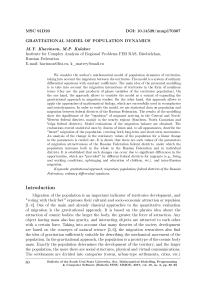Gravitational model of population dynamics
Автор: Khavinson M.Y., Kulakov M.P.
Рубрика: Математическое моделирование
Статья в выпуске: 3 т.10, 2017 года.
Бесплатный доступ
We consider the author's mathematical model of population dynamics of territories, taking into account the migration between the territories. The model is a system of ordinary differential equations with constant coefficients. The main idea of the presented modelling is to take into account the migration interactions of territories in the form of nonlinear terms (they are the pair products of phase variables of the territories population). On the one hand, the approach allows to consider the model as a variant of expanding the gravitational approach in migration studies. On the other hand, this approach allows to apply the approaches of mathematical biology, which are successfully used in econophysics and sociodynamics. In order to verify the model, we use statistical data on population and migration between federal districts of the Russian Federation. The results of the modelling show the significance of the "repulsion" of migrants arriving in the Central and North-Western federal districts, mainly in the nearby regions (Southern, North Caucasian and Volga federal districts). Model evaluations of the migration balance are obtained. The evaluations exceed statistical ones by dozens of times and, to all appearances, describe the "latent" migration of the population, covering both long-term and short-term movements. An analysis of the change in the stationary values of the population for a linear change in the parameters is carried out. It is shown that there are such values of the parameters of migration attractiveness of the Russian Federation federal districts, under which the population increases both in the whole in the Russian Federation and in individual districts. It is established that such changes can occur due to significant differences in the opportunities, which are "provided" by different federal districts for migrants (e.g., living and working conditions, upbringing and education of children, etc.), and intra-Russian migration.
Gravitational approach, migration, population, federal districts of the russian federation, ordinary differential equations
Короткий адрес: https://sciup.org/147159445
IDR: 147159445 | УДК: 51-7+314.15 | DOI: 10.14529/mmp170307
Список литературы Gravitational model of population dynamics
- Мищук, С.Н. Особенности международной трудовой миграции из Китая в Россию (на примере Дальневосточного федерального округа)/С.Н. Мищук//Экономика региона. -2014. -№ 2 (38). -С. 194-202.
- Мищук, С.Н. Ретроспективный анализ миграционных процессов в Еврейской автономной области/С.Н. Мищук//Региональные проблемы. -2015. -Т. 18, № 3. -С. 74-81.
- Motrich, E.L. Migration Processes in the Socioeconomic Development of the Far East/E.L. Motrich, S.N. Naiden//Studies on Russian Economic Development. -2015. -Issue 26. -№ 5. -P. 491-498.
- Khavinson, M.Yu. Prediction of Foreign Labor Migration Dynamics at the Regional Level/M.Yu. Khavinson, M.P. Kulakov, S.N. Mishchuk//Studies on Russian Economic Development. -2013. -V. 24, № 2. -P. 170-178.
- Романовский, М.Ю. Введение в эконофизику: статистические и динамические модели/М.Ю. Романовский, Ю.М. Романовский. -М.; Ижевск: Ин-т компьютерных исследований, 2012. -340 с.
- Хавинсон, М.Ю. Эконофизика: от анализа финансов до судьбы человечества/М.Ю. Хавинсон//Пространственная экономика. -2015. -№ 1. -С. 144-166.
- Василенко, П.В. Гравитационные силы и миграционная подвижность населения региона/П.В. Василенко//Вестник Балтийского федерального университета им. И. Канта. Серия: Естественные и медицинские науки. -2013. -Вып. 7. -С. 155-159.
- Драпкин, И.М. Гравитационный подход к эмпирической оценке факторов прямых зарубежных инвестиций в российской экономике/И.М. Драпкин, О.С. Мариев, К.В. Чукавина//Вестник Уральского федерального университета. Серия: Экономика и управление. -2014. -№ 6. -С. 58-66.
- Каукин, А.С. Особенности эмпирических оценок гравитационной модели внешней торговли России/А.С. Каукин//Российский внешнеэкономический вестник. -2013. -№ 4. -С. 71-84.
- Чернавский, Д.С. Синергетика и информация: Динамическая теория информации/Д.С. Чернавский. -М: УРСС, 2016. -304 с.
- Ризниченко, Г.Ю. Биофизическая динамика продукционных процессов/Г.Ю. Ризниченко, А.Б. Рубин. -М.; Ижевск: Ин-т компьютерных исследований, 2004. -464 с.
- Frisman, E.Ya. Complex Dynamics of the Population with a Simple Age Structure/E.Ya. Frisman, G.P. Neverova, O.L. Revutskaya//Ecological Modelling. -2011. -V. 222. -P. 1943-1950.
- Лобанова, Е.В. Гладкие модели биологических популяций/Е.В. Лобанова, Н.Б. Медведева//Вестник ЮУрГУ. Серия: Математическое моделирование и программирование. -2014. -Т. 7, № 2. -С. 55-65.
- Кулаков, М.П. Мультистабильность в моделях динамики миграционно-связанных популяций с возрастной структурой/М.П. Кулаков, Г.П. Неверова, Е.Я. Фрисман//Нелинейная динамика. -2014. -Т. 10, № 4. -С. 407-425.
- Weidlich, W. Sociodynamics: a Systematic Approach to Mathematical Modelling in the Social Sciences/W. Weidlich. -Boca Raton: CRC Press, 2000. -392 p.
- Официальный сайт Федеральной службы государственной статистики. -URL: http://www.gks.ru (дата обращения: 05.05.2016).
- Демографический ежегодник России. 2015: стат. сб./Росстат. -М., 2015. -263 с.


